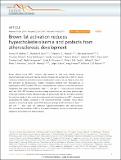Brown fat activation reduces hypercholesterolaemia and protects from atherosclerosis development

View/
Author
Berbée, Jimmy F. P.
Boon, Mariëtte R
Khedoe, P. Padmini S. J.
Schlein, Christian
Worthmann, Anna
Kooijman, Sander
Hoeke, Geerte
Mol, Isabel M.
John, Clara
Jung, Caroline
Vazirpanah, Nadia
Brouwers, Linda P.J.
Gordts, Philip L.S.M.
Esko, Jeffrey D.
Hiemstra, Pieter S.
Havekes, Louis M.
Scheja, Ludger
Heeren, Joerg
Rensen, Patrick C.N.
Note: Order does not necessarily reflect citation order of authors.
Published Version
https://doi.org/10.1038/ncomms7356Metadata
Show full item recordCitation
Berbée, J. F. P., M. R. Boon, P. P. S. J. Khedoe, A. Bartelt, C. Schlein, A. Worthmann, S. Kooijman, et al. 2015. “Brown fat activation reduces hypercholesterolaemia and protects from atherosclerosis development.” Nature Communications 6 (1): 6356. doi:10.1038/ncomms7356. http://dx.doi.org/10.1038/ncomms7356.Abstract
Brown adipose tissue (BAT) combusts high amounts of fatty acids, thereby lowering plasma triglyceride levels and reducing obesity. However, the precise role of BAT in plasma cholesterol metabolism and atherosclerosis development remains unclear. Here we show that BAT activation by β3-adrenergic receptor stimulation protects from atherosclerosis in hyperlipidemic APOE*3-Leiden.CETP mice, a well-established model for human-like lipoprotein metabolism that unlike hyperlipidemic Apoe−/− and Ldlr−/− mice expresses functional apoE and LDLR. BAT activation increases energy expenditure and decreases plasma triglyceride and cholesterol levels. Mechanistically, we demonstrate that BAT activation enhances the selective uptake of fatty acids from triglyceride-rich lipoproteins into BAT, subsequently accelerating the hepatic clearance of the cholesterol-enriched remnants. These effects depend on a functional hepatic apoE-LDLR clearance pathway as BAT activation in Apoe−/− and Ldlr−/− mice does not attenuate hypercholesterolaemia and atherosclerosis. We conclude that activation of BAT is a powerful therapeutic avenue to ameliorate hyperlipidaemia and protect from atherosclerosis.Other Sources
http://www.ncbi.nlm.nih.gov/pmc/articles/PMC4366535/pdf/Terms of Use
This article is made available under the terms and conditions applicable to Other Posted Material, as set forth at http://nrs.harvard.edu/urn-3:HUL.InstRepos:dash.current.terms-of-use#LAACitable link to this page
http://nrs.harvard.edu/urn-3:HUL.InstRepos:15034842
Collections
- SPH Scholarly Articles [6362]
Contact administrator regarding this item (to report mistakes or request changes)


